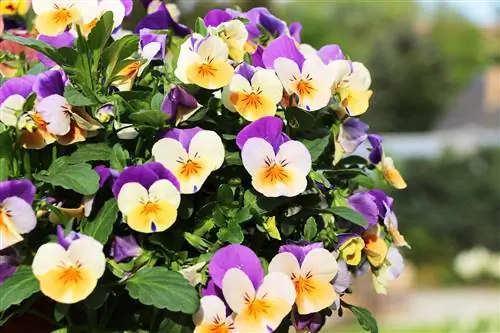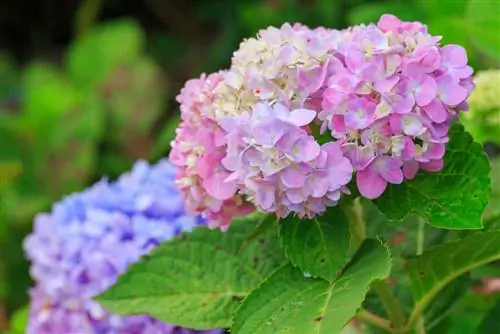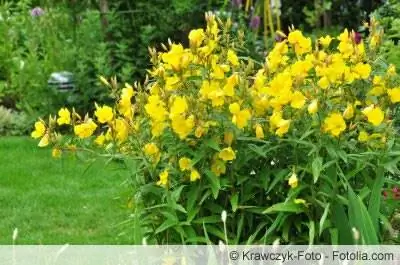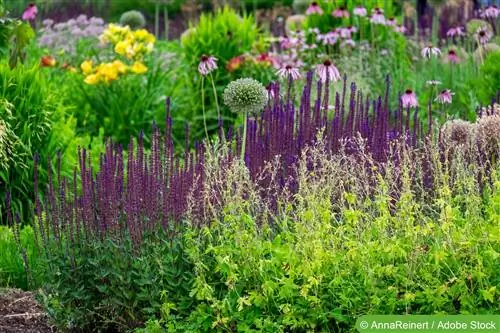- Author admin [email protected].
- Public 2023-12-17 03:39.
- Last modified 2025-01-24 12:45.
Pansies belong to the violet family, our garden pansy was created from crosses of the wild pansy, which is native to Europe and Asia. Wild pansies are upright plants up to 25 cm high that can be found in fields, meadows and pastures in yellow, white and purple. Our ancestors valued the wild pansy primarily as a medicinal plant and it is still used in natural medicine today: In addition to skin diseases, sore throats, rheumatism and digestive problems are also treated externally and internally with wild pansy.
Pansies in garden shops
Pansies are mainly offered in two forms on the German market:
- as a young plant ready for planting
- or as seeds
Especially for beginners in the gardening world, it is often tedious to properly care for pansies all the way from seedling to fully grown plant. Young plants are a lot more robust and you can't really go wrong with them. However, often only particularly established species are offered as plants, as these “classics” sell best. The selection of flower colors available is much larger when growing pansies from seeds.
Sowing pansies
As with all plants, sowing pansies depends on the suitability of the plant to germinate in a certain time and on the desired flowering time. Pansies sown in late May to mid-June often bloom in the autumn sun before their first winter. As so-called two-year-olds, pansies should definitely be sown from the end of May, but before the beginning of August. If you sow late, you will see why these plants are called biennials: In their first year they are completely busy developing from seeds into complete plants and can therefore only bloom the next year.
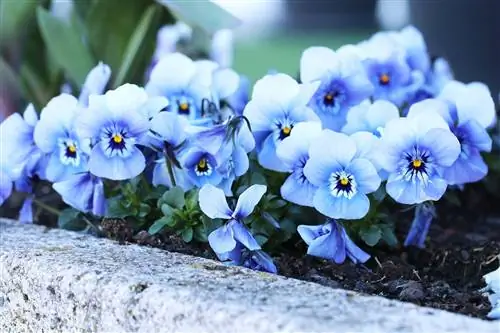
When germinating, it should be noted that, unlike the adult plants, the seeds tend to be a little darker. Therefore, the seed pot or seed bed can be darkened, for example with a jute sack or sack. It is important that the material still allows good air circulation so that no waterlogging can form between seedlings and the covering material, which often leads to infestation with unwanted fungi. It is essential to prevent the seedlings from drying out, as this often means the end of the delicate plants.
Watering pansies
It is ideal for pansies if the soil in which they live is usually slightly moist. Whether watering is necessary depends on the season and the weather and is easiest to find out by “feeling” the soil. However, especially with potted plants, you should avoid watering them too often. Here, less can clearly be more. Too much water on the roots promotes the occurrence of root rot. Pansies don't mind if you forget to water them, as long as you don't neglect them for too long. This quickly becomes noticeable as the plants look increasingly wilted. Nevertheless, pansies should of course not be exposed to strong sun for too long without an adequate supply of water and regular watering should be mandatory.
Tip:
If the pansies are wilting despite regular but not excessive watering, they should also be checked for pests at the roots.
Planting pansies
A good idea is to get young pansies, which are supposed to bloom from around the end of April next year, used to the planned soil in the winter months. To do this, you plant them in the desired soil in the winter months. The distance between the pansies should only be a few centimeters if you want them to completely cover the ground. A distance of around three centimeters is often ideal here. Of course, there's nothing wrong with planting the pansies further apart if you don't want them to completely cover the ground.
More care tips
Location
Young and adult pansies love the sun. However, a shady spot is often preferable for germination. Conventional potting soil, available at supermarkets or hardware stores, is suitable as soil for the pansies. But they are not picky as long as the soil contains lots of nutrients and is well mixed with humus.
Other care
With pansies, it is important to ensure that the plants are regularly removed from damaged or dead plant parts. These can easily be separated from the plant using the usual garden tools (secateurs).
Wintering
To protect the pansies from cold and frost in winter, you can cover the bed with the usual materials such as leaves or small twigs. In this way, the plants are protected from the cold and do not lose too much moisture, which is often difficult to absorb again in winter.
Pests
A well-known enemy of pansies and other popular garden plants among many gardening enthusiasts is powdery mildew. Mildew got its name because of the flour-like layer with which it covers the areas of the plants it infects. These can therefore be easily identified visually and removed to prevent the fungus from spreading further. Sometimes a variation of powdery mildew also appears under the leaves. Here you can take precautions through regular checks so that the necessary countermeasures can be taken in good time.

But the red spider (fruit tree spider mite) also attacks pansies from time to time, but is eaten by ladybirds. If there are a large number of ladybirds in your own garden, this pest has no chance. More critical, because it is often overlooked, is an infestation of the roots with small worms. If the pansies are wilting inexplicably, such a test (digging up individual plants) and the corresponding countermeasures can pay off.
What you need to know about pansies in brief
Pansies are among the most popular ornamental flowers in German-speaking countries. They are easy to care for and easy to handle even for beginners or hobby gardeners with little time, as long as you stick to a few important points such as regular watering.
- ideal location is lots of sun to light shade
- permeable soil
- plenty of water, but no wet feet
- fertilize only moderately!
- if too much fertilization is applied, the shoots become excessively long and cannot hold the heavy flowers
- Seed varieties are easy to propagate, but they often don't bloom as persistently
- Propagation from cuttings is better, although it takes more effort, but the pansies are compact and bloom for a long time
- Remove spent flowers regularly, then the plants will sprout again quickly
- Divide varieties propagated from cuttings after two to three years
- cover with some spruce branches in winter
- It is better to plant in spring than in autumn, as this gives the roots longer time to spread and establish themselves
Particularly beautiful pansy varieties
There is a large selection of breeding forms. They differ in their colors, shapes and shades. Even multiple flower colors on just one flower are possible. The choice of colors for home-grown (sown) pansies is significantly larger than the selection in stores. Orchid-flowered pansies are particularly beautiful.
- F2 hybrid, 'Joker Poker Face' (dark purple to red barun with large orange face)
- 'Joker', 'Red-Gold' Viola wittrockiana F1 hybrid (dark red with large yellow face)
- ‘Giant Harbinger Golden Orange’ Viola wittrockiana (very orange)
- 'Swiss Giant Mountain Rescue' Viola velvet blue (dark purple)
- ‘Giant Vorbote® Silverwing’ (large-flowered, dark purple and white)
- 'Viola Red Wing', yellow with red petale red/yellow with dark eye)
- ‘Jolly Joker’ F2 DÜ E (deep purple with orange center)
- ‘Cats’ F1 (purple-white)
- ‘Alpine Lake’ Viola wittrockiana (deep blue with small black eye)
- ‘Tempo Blue-White’ Viola wittrockiana (purple blue with white wings)

